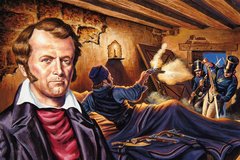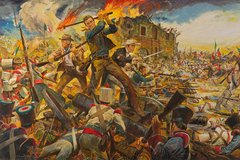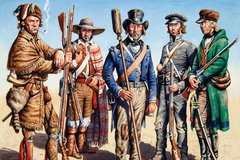What was it that Miranda had found? The most common image of a silver mine is a deep shaft cut into a mass of hard rock that contains gleaming veins of silver running through it. The silver of San Saba was nothing of the sort, though. The Spanish referred to the suspected deposits as almagre, a reddish colored earth also known as red ochre. These soils were alluvial deposits formed from the natural weathering of red granite found in central Texas. In addition to oxidized iron or hematite, which gives these deposits their reddish appearance, other trace elements — including silver — may be found in these soils. The region where these almagres existed was located approximately seventy-five miles northwest of San Antonio. As the Spanish learned, working these deposits would not be feasible if the ore had to be sent to Mexico City for smelting. Therefore, in addition to providing a mission for Apache, the mission-presidio community on the San Saba River was expected to provide the support necessary to establish mining camps in the area. Those hopes were dashed on March 16, 1758, when two thousand Comanches sacked and burned Mission Santa Cruz de San Saba, demonstrating that the region was still too dangerous for mining activity.
But the notion of rich silver mines near the San Saba River had taken hold in the public’s mind. Stephen F. Austin, whose family had owned a lead mine in Missouri, first learned from his guide, Erasmo Seguín, about the silver deposits on his first visit to Texas. Later, looking for ways to draw settlers to his colony, Austin marked the suspected location of the old Spanish silver mine on his 1829 map of Texas. His cousin, Mary Austin Holley, also mentioned the mine in her 1836 book, Texas, writing, “tradition says, that a silver mine on the San Saba [River] was successfully wrought many years ago, but the prosecution of it was arrested by the Indians, who cut off the workmen.”[i] Talk of the abandoned silver mine also had caught the attention of Rezin P. Bowie and his younger brother, James. Both Rezin and James left accounts of their trip to find the San Saba silver, and their subsequent epic fight with Indians near the site of the old mission.
The Bowie expedition, which had secured the permission of Political Chief Ramón Músquiz, left San Antonio de Béxar on November 2, 1831. In addition to the two Bowie brothers, the party consisted of Robert Armstrong, Thomas McCaslin, Daniel Buchanan, James Corriell, Mateo Dias [Matthew Doyle?], Cephas K. Ham, Jesse Wallace, Señor Gonzales, and a mulatto named Charles. It is apparent from both Rezin’s and James’ accounts that the latter two individual went along as servants. After travelling for two-weeks, the party had a chance encounter with friendly Comanches on their way to Béxar to return stolen horses. The Indians warned the group that “124 Tahuacanos” were trailing them with the intent of catching and killing their small party. Determined to push ahead anyway, they continued onward towards the site of the old Spanish mission. Unable to locate its ruins, the group bedded down for the night of November 20 in a grove of live oaks, three miles north of the river. They awoke on the morning of the 21st to find that the Comanches’ warning had been accurate. The battle that followed would add to Rezin and James Bowie’s growing fame.
Spotting a large body of Indians waiting to attack them in the open after they left the grove, the party quickly retreated and took up a defensive position within the trees. After an opening exchange of shots, their attackers withdrew to hilltops that overlooked the grove, and kept up a lively fire for several hours. Some Indians also took cover in a nearby creek bed from which they fired. About mid-day the Tahuacanos changed tactics, and set fire to the prairie next to the grove, hoping the smoke would drive the party from their cover. Señor Gonzales and Charles were put to work building breastworks out of saddles, packs, and any loose branches they could find. During the afternoon, the larger part of the Indians withdrew to a pond about one and a half miles distant but left several riflemen in place to keep their prey pinned down. According to Rezin and Bowie, the defenders survived the siege by immediately changing their positions after firing, thereby keeping their location hidden. The fighting finally ended about dusk, with both sides contemplating their next move.
The morning light revealed to the besieged party that their attackers had left during the night. Rezin and James later claimed to have witnessed twenty-one Indians killed outright in the battle, and later found forty-eight bloody spots on the ground. However, the losses to their own party kept them and their companions in their fortified camp for more than a week. McCaslin had been killed and three others — Buchanan, Doyle, and Corriell — were wounded in the fray. Additionally, five horses had been killed and, three other horses were rendered useless due to their injuries. The party erected a flag on a long pole over their camp to show their foe that they still were ready to fight. Moreover, the party kept a fire burning constantly for eight days in the hope of attracting friendly Comanche Indians to their aid. The party finally broke camp on November 29, limping back into San Antonio de Béxar on the evening of December 6, 1831. Although James Bowie evidently hoped to make another attempt to locate the mine at San Saba, there is no evidence that he ever returned to the mine before his death at the Alamo on March 6, 1836.
A 20th century search for San Saba silver took place not on the river but at the Alamo. In 1995, a historical researcher named Frank Buschbacher convinced the producers of TV’s Unsolved Mysteries that James Bowie had found the lost silver mine and reaped its wealth. Buschbacher theorized that Bowie had carried his treasure with him into the Alamo and hid it in a well located near the southeast corner of the Long Barrack. After securing the required permits, an excavation supervised by the Department of Archaeology at St. Mary’s University commenced. The dig ended several weeks later, however, without any treasure being discovered, proving once more the elusive nature of San Saba’s fabled silver.
Sources
Alamo Treasure. Accessed November 15, 2018.
[Bowie, James], “Bowie’s Battle with Indians at Calf Creek.” Accessed November 15, 2018.
[Bowie, Rezin], “An Indian Battle,” [Samuel Coate] Atkinson’s Casket or Gems of Literature, Wit & Sentiment. September 1, 1833. Page: 422–425.
Holley, Mrs. Mary Austin, Texas. Lexington, KY: J. Clark & Son, 1836; Austin: Texas State Historical Press, 1990.
Patten, Roderick B., trans. and ed., “Miranda’s Inspection of Los Almagres: His Journal, Report, and Petition,” Southwestern Historical Quarterly, Vol. 74, №2 (October 1970), 223–254.
[i]Holley, Mrs. Mary Austin, Texas. (Lexington, KY: J. Clark & Son, 1836; facsimile, Austin, TX: Texas State Historical Press, 1990), 76.



